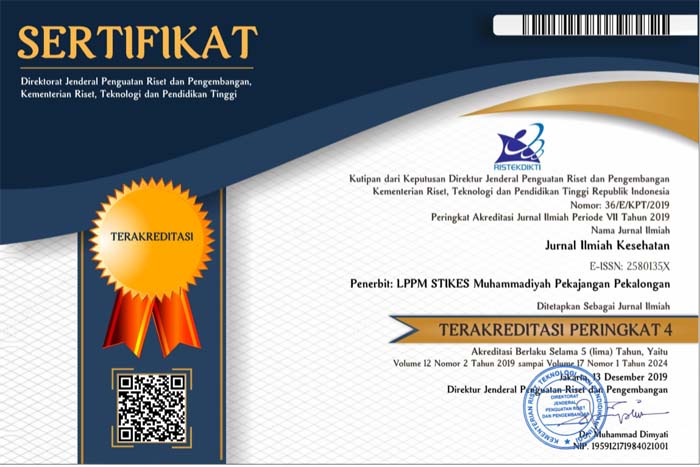Keterlibatan Dukun Bayi Dalam Pertolongan Persalinan
DOI:
https://doi.org/10.48144/jiks.v16i1.1379Keywords:
Traditional Birth Attendant; Childbirth, Keterlibatan; Dukun Bayi; PersalinanAbstract
One of the Sustainable Development Goals is to reduce the Maternal Mortality Rate in 2030 to 70 deaths per 100,000 live births. In 2022 the number of deliveries in Tegal Regency is 26,679 (96.41%) vaginal deliveries 26,282 (95.6%) assisted by health workers in health care facilities 241 (0.9%) are in non-health care facilities 156 (0 .6%) assisted by non-medical health workers. In 2022, 13 maternal deaths are dominated by 60% postpartum hemorrhage, 20% embolism, 10% edema, and others. The Bumijawa Community Health Center is the largest number of delivery assistance places in Tegal Regency. In 2022 there will be 1,685 vaginal deliveries consisting of 87.7% health workers and 5% non-health workers; even though the target is 97%. The purpose of this study was to determine the involvement of traditional birth attendants in assisting with childbirth. Data collection was carried out by in-depth interviews and data reduction, demonstrated by narration, using the triangulation method, and analyzed by saturated samples. The research informants were 3 mothers who had given birth with a dukun as the main informant, 3 dukun and a midwife as triangulation informants. The results showed that the mother's decision to choose birth attendants was related to experience, knowledge, attitudes, access to services, husband and family support, local culture; This can be seen from the level of public awareness of health which is still low
References
S. Nurhidayanti, A. Margawati, and M. I. Kartasurya, “Kepercayaan Masyarakat terhadap Penolong Persalinan di Wilayah Halmahera Utara,” J. Promosi Kesehat. Indones., vol. 13, no. 1, p. 46, 2018, doi: 10.14710/jpki.13.1.46-60.
R. D. Parenden, “Analisis Keputusan Ibu Memilih Penolong Persalinan Di Wilayah Puskesmas Kabila Bone Analysis of Decision Mother to Choosing Delivery Helper In Kabila Bone Health Center,” Bapelkesman Propinsi Gorontalo 2) Fak. Ilmu Kesehat. Masy. Univ. Sam Ratulangi Manad., vol. 5, NO, pp. 362–372, 2015.
Nurgahayu. and A. R. Amelia, “Alasan Pemilihan Penolong Persalinan oleh Ibu Bersalin di Pulau Papandangan Kel Mattiroujung Kec Liukang Tupabbiringin Kab Pangep,” Desain Pembelajaranenglish Formath Berbas. Blended Learn., vol. 1, no. April, pp. 78–83, 2018, [Online]. Available: https://jurnal.yapri.ac.id/index.php/semnassmipt/article/download/36/36/
Kasnodihardjo, L. Kristiana, and T. J. Angkasawati, “The Role of Traditional Birth Attendans To Support Maternal and Child Health Care,” Media Penelit. Dan Pengemb. Kesehat., vol. 24, no. 2, pp. 57–66, 2014.
A. Said, I. Budiati, H. A. Reagan, and Dkk, Potret awal tujuan pembangunan berkelanjutan (Sustainable Development Goals) di Indonesia. 2016. [Online]. Available: https://filantropi.or.id/pubs/uploads/files/3 BPS Potret Awal TPB di Indonesia.pdf
D. S. Aristin Sofyan, A. Khoiri, E. Witcahyo Bagian Administrasi dan Kebijakan Kesehatan, and F. Kesehatan Masyarakat Universitas Jember Jln Kalimantan, “Sofyan et al., Peran Dukun dalam Implementasi Kemitraan Bidan dan Dukun di Wilayah Kerja … Peran Dukun dalam Implementasi Kemitraan Bidan dan Dukun di Wilayah Kerja Puskesmas Bangsalsari Kabupaten Jember (The Role of Traditional Birth Attendance in the Implementation of Partnership between Midwife and Traditional Birth Attendance at Bangsalsari Community Health Center in Jember District),” J. Pustaka Kesehat., vol. 3, no. 2, p. 334, 2015.
“profil-kes-kab-tegal-tahun-2018.pdf.”
N. Mulyono, S. Sudibyo, I. K. Riyasa, and M. Riyanto, “Sikap dan aktivitas bidan di desa membina dukun bayi dalam menolong persalinan dan merawat bayi The attitude and activities of midwife in the village in establishing traditional birth attendance in helping childbirth and caring the babies,” vol. 13, no. 29, pp. 1–10, 2005.
R. S. Prastiwi, U. R. Budihastuti, and ..., “Studi Fenomenologi: Peran Dukun dalam Kesehatan Ibu dan Bayi di Kabupaten Brebes,” J. Kebidanan Harapan Ibu Pekalongan, vol. 2, 2017, [Online]. Available: http://akbidhipekalongan.ac.id/e-journal/index.php/jurbidhip/article/view/22
Dinas Kesehatan Wonosobo, “Profil Kesehatan Kabupaten Wonosobo Tahun 2019,” J. Chem. Inf. Model., vol. 53, no. 9, pp. 1689–1699, 2019.
A. Arma and S. Sagita, “Hubungan Paritas Dengan Kejadian Ketuban Pecah Dini Pada Ibu Bersalin,” Kesehatan, pp. 1–13, 2015.
S. Maryam and E. Rustiana, “Kemitraan Dukun Bayi Dan Bidan Terhadap Pelayanan Kesehatan Ibu Dan Anak,” J. BONOROWO, vol. 2, no. 1, pp. 23–32, 2014, [Online]. Available: http://www.jurnal-unita.org/index.php/bonorowo/article/view/28
Ervina, S. Moita, and Sarpin, “Bentuk kemitraan bidan dan dukun bayi dalam pelayanan kesehatan (studi di Kecamatan Wawonii Utara Kabupaten Konawe Kepulauan),” Neo Soc., vol. 3, no. 2, pp. 467–475, 2018.
A. D. Erawati, ASPEK LEGAL KEBIDANAN DAN ETIKA BIDAN Ambar Dwi Erawati, S.Si.T.,M.H.Kes. 2020.
ahmad fauzi, “Peran Dan Kedudukan Dukun Bayi Di Desa Sriwungu, Kecamatan Tlogomulyo, Kabupaten Temanggung,” pp. 2–3, 2015.
R. S. Sulistyo, “Peran Dukun Bayi dalam Edukasi Ibu pada Masa Kehamilan dan Pascamelahirkan di Kecamatan Todanan.” 2019.
“157851-tinjauan-kepustakaan-mengenai-peranan-du-01946a52.pdf.”
L. E. S. Bustami, A. A. Insani, D. Iryani, and Yulizawati, Buku Ajar Kebidanan Komunitas. 2017.
Y. Media, Z. Arifin, and Gusnedi, “Hambatan Dan Potensi Sumber Daya Lokal Dalam Upaya Mengurangi Resiko Kematian Ibu Di Kecamatan Tigo Lurah Kabupaten Solok, Provinsi Sumatera Barat,” J. Kesehat. Reproduksi, vol. 5, no. 1, pp. 1–13, 2014.
D. Purnamawati and A. Ariasih, “Pertolongan Persalinan oleh Dukun Bayi selama Pandemi Covid-19,” Semin. Nas. Penelit. LPPM UMJ, pp. 1–6, 2021, [Online]. Available: http://jurnal.umj.ac.id/index.php/semnaslit












